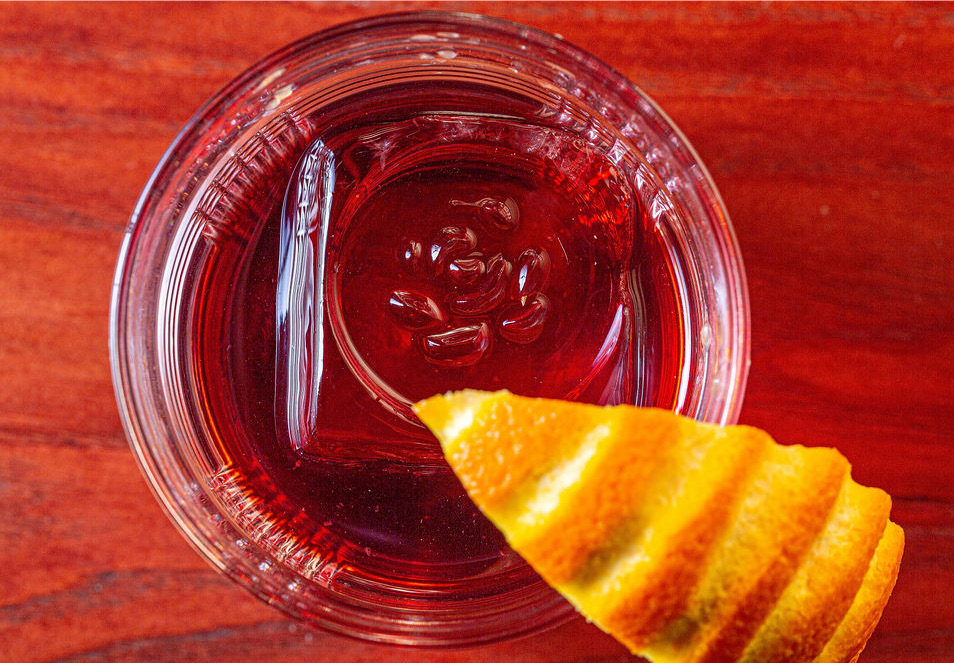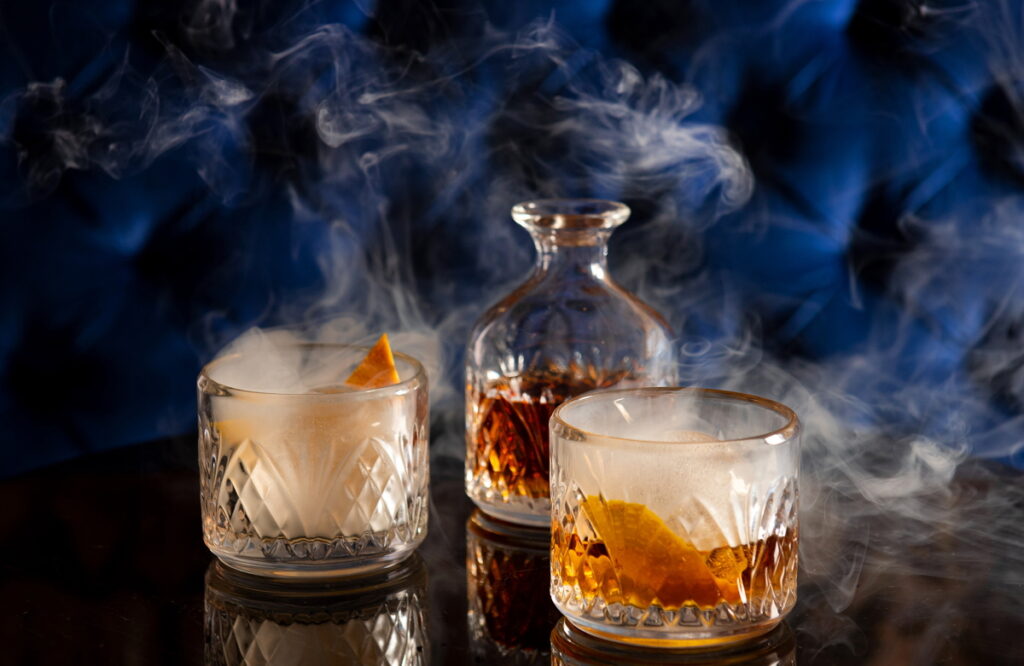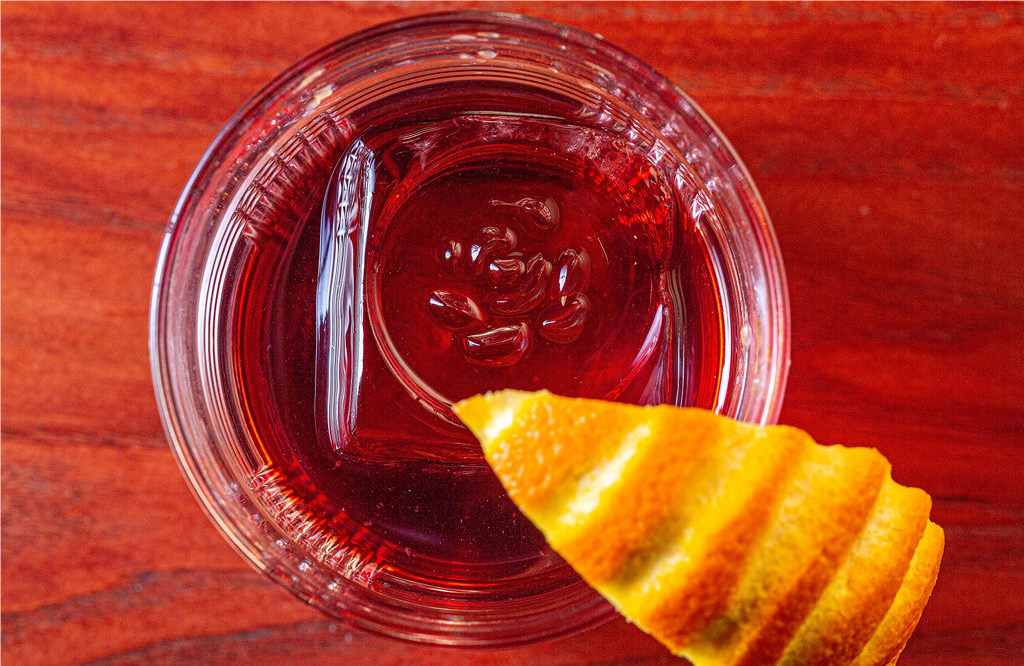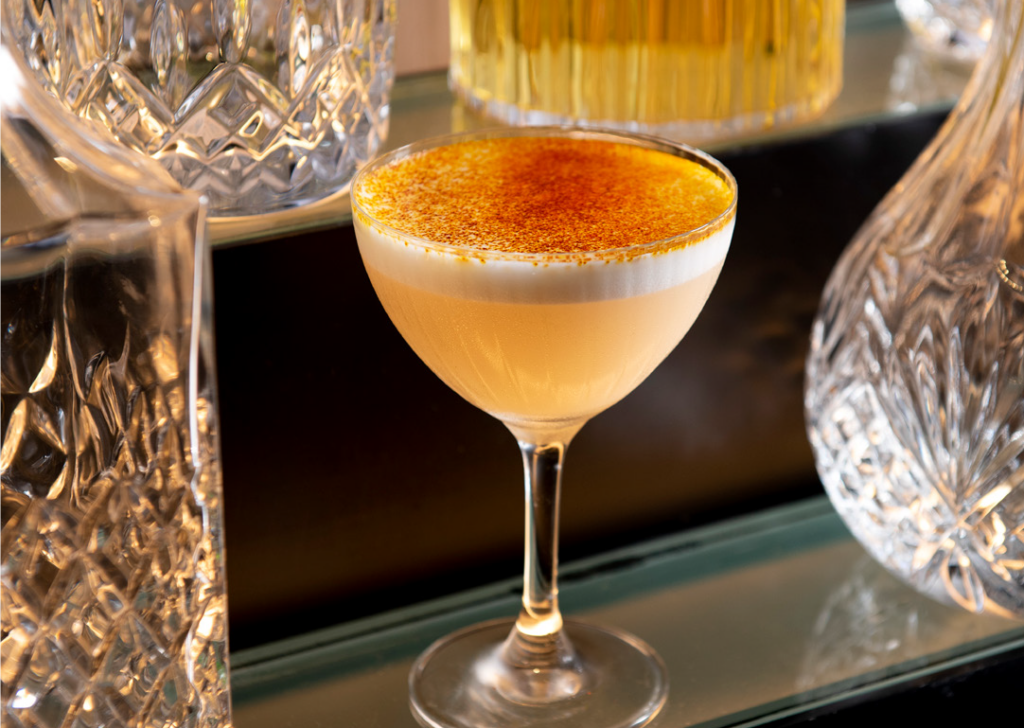

The Twin Fashioned, with star anise and clove smoke. Photo courtesy of Bar Chrystie. By Liz Clayman.
How Bars Can Craft More Appealing—Yet Profitable—Cocktail Presentations
By Laura Burgess
“When I say ‘Martini,’ you see a Martini,” explains Robert Krueger, the head bartender for John Fraser Restaurants, pointing to the classic cocktail’s signature thin-stemmed glass, clear appearance, and lemon-peel or olive garnish. “The goal for every cocktail we make is for it to have its own silhouette that’s as distinctive and iconic as the classics.”
While visions of perfect Martinis and Mojitos are easy to imagine and recreate, cocktail presentation isn’t limited to glassware and garnishes. “The presentation of the drink starts way before shaking and garnishing,” Krueger adds. The presentation process includes every action from ordering through serving, and varies from low-key pouring to Cirque-du-Soleil-level showmanship, but what matters most is a sense of purpose throughout the process.
“Watching someone doing work with concentration is inherently intriguing, so if the bartender is focused on the process, that will always elevate the moment of garnishing and the act of presentation,” explains Krueger. “Cocktail hour is the time of day where work is over, and a cocktail is a license to relax.”
By focusing on the guest experience and creating a deliberate strategy for presentation, constructing and serving gorgeous cocktails can become second nature, without sacrificing margins or valuable prep time.
Use Ice to Add Intrigue
“Ice is one of the most overlooked and underestimated aspects of drink making,” explains Jessica “Rabbit” King, the owner-operator of Knoxville, Tennessee’s Brother Wolf and Sapphire. “Ice matters from both an aesthetic perspective and also from a cost perspective.” In addition to making the cocktail look beautiful, the size, shape, quality, and fit of the ice in the glass directly relates to cocktail profitability.
While custom ice, like the large, branded cubes in Brother Wolf’s signature barrel-aged Negroni, can be costly, King believes presentation doesn’t need to detract from the bottom line. Instead, she recommends bartenders and managers keep a close eye on standard formulas—including the cost of the ice, straws, and glassware—to price drinks efficiently.

Brother Wolf’s barrel-aged Negroni, with branded ice. Photo by Tom Bell Blankenship.
Deke Dunne, the bar director at Washington, D.C.’s Allegory, an Alice in Wonderland-themed speakeasy within the Eaton Hotel, agrees with King. “Ice is the easiest way to make something feel more special,” he says. “Take a vodka-soda and put a long, clear spear of ice in it, and you’ve just elevated that cocktail by a mile.”
King also recommends considering how the glass factors into the presentation, particularly when considering the type and amount of ice used. “A glass can make the difference between two ounces of liquor looking skimpy or looking like three and a half ounces,” says King. “It’s not trickery—it’s thoughtfulness and really managing your program so every single drink is presented in the best light.”
Repurpose Ingredients for Presentation
Garnish and glassware costs can easily spiral, especially if drinks are presented with fresh ingredients that have a short shelf life. As a result, many of the best cocktail programs rely on sustainable and reusable presentation elements, while purposefully sourcing fresh items.
“I challenge my team by saying they can only have a garnish if it’s a byproduct of an ingredient we use. We care about sustainability at our bar and that also adds to the story,” says Dunne, who also advocates for reusable garnishes like the specialty glowing coasters used in Allegory’s You Can’t Kill Us All, a clarified milk punch. “It’s great because we can use six coasters for six months rather than using hundreds of other items.”
Brian Evans, the bar director for Sunday Hospitality Group in New York City, agrees. “The last thing you want to do is upset operators with unexpected costs,” he says, noting that creative sourcing can mitigate presentation-related expenses. “Think about a pineapple—you can create six types of garnishes from a single fruit if you commit to using the peel, fronds, and the pineapple itself.”

Allegory’s They Can’t Kill Us All cocktail, lit by a reusable coaster. Photo by Kimberly Kong.
Similarly, Evans advocates for tweaking traditional garnishes to add an artistic edge to classic drinks. “You can trim citrus peels with patterned scissors to make a zig-zag pattern or square edges,” he says, adding that many tools cost less than $10. “When you make patterned cuts, the fruit actually unleashes more aromas. The twisting pattern and those extra aromas just add a degree of thoughtfulness to the drink without adding much effort.”
California-based cocktail consultant Rosie Grillo similarly points out that cocktail presentation programs within restaurants can take advantage of the wide array of ingredients often on site. “Chefs are a secret weapon for garnishes,” she says. “Berries that aren’t pretty enough for a cheesecake could make a gorgeous berry syrup to swirl into a drink, or extra jalapeños could be smoked and turned into a show-stopping element in a tequila drink.”
Prepare with Visual Presentation in Mind
From preparing a perfect mise-en-place to batching signature cocktails in advance, the secret to creating ovation-worthy presentations is understanding both sides of the bar. “Visuals can be the main draw for guests to come in for the first time, whether they’ve seen a picture on social media or in a magazine,” says Grillo. “That imagery inspired them from afar, so you want to preserve the magic when they experience the bar in person.”
Understanding the guest perspective, especially in terms of presentation, reinforces the value of preparedness behind the bar. Having perfectly prepared garnishes, clean tools, and easy access to ingredients literally sets the stage for great presentation.

The Silk Road Sour at Bar Chrystie in NYC.
“The number one thing I teach is that if a garnish isn’t perfect when you cut it … then it has no place going into your mise-en-place at the bar,” Krueger says. “There should never be a chance to pull a garnish that would be rejected.”
Dunne agrees, and suggests bartenders place their tools and garnishes in an ergonomic location for easy access during service. At Allegory, that means a large mise-en-place in the center of the bar, and pre-cutting garnishes to exacting standards so they sit perfectly in each glass. In addition, the Allegory pre-batches complex drinks before service to maintain consistency, control waste, and present each cocktail quickly.
“We pre-batch everything we can,” says Dunne, noting the simple step of combining certain ingredients before service can turn a 10-step cocktail into a two-step drink, saving time and enhancing the guest experience on busy nights. “Batching produces such an amazing drink consistently and guests are still getting the experience of a drink being made just for them.”
To keep costs in check and reduce waste when prepping, Krueger recommends incorporating data from point-of-sale systems. “Ordering and preparation of garnishes should be done in reasonable proportion to the popularity of a given item based on sales projections. You should know whether you sell five of something in a night, or 55, or 500.”
Conscientious sourcing, deliberate garnishing, and an eye for sustainability can take a drink from drab to dazzling—a transformation that can likewise turn any patron into a licensed-to-relax regular. And there’s nothing better for bartenders, guests, and the bottom line than that.



